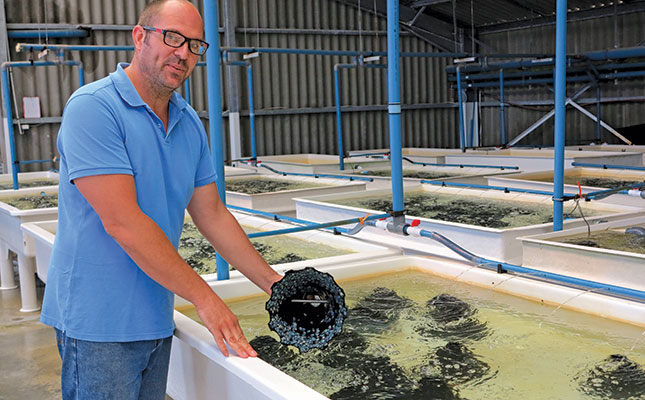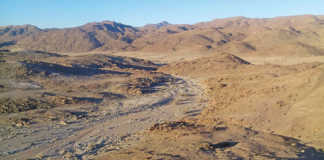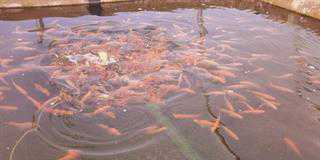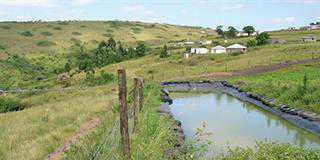
Photo: Keri Harvey
Jacobsbaai Sea Products started farming abalone in 1995. Before that, the operation raised oysters and trout.
General manager Jonathan Venter, a zoologist by training, has been working on the farm since 2003. In that time, the operation has virtually doubled in size, and is currently being expanded by a further 75% in a bid to meet market demand.
Ideal farming conditions
In the early days of commercial abalone production, farmers were highly secretive. Today, however, the industry is stable, and they are willing to share information.
Industry players also meet formally on a regular basis to discuss matters of common interest, including problems with regulation, permits and compliance.
Venter explains that the West Coast’s water quality is good and the temperature is stable.
“The South African abalone species doesn’t like water that’s too warm, so they don’t occur naturally far up the East Coast.”

Abalone generally tolerate sea temperatures up to about 25°C. When the water is too warm, there is a risk of mortalities, and when the water is too cold, their growth is too slow as they are cold-blooded.
“Here, the coldest ocean temperatures occur in winter, and it can go down to 10°C, but summer can be cold too, at about 12˚C. When there’s no wind in summer, the sea temperature can be 17°C in the mornings and sometimes touching the low twenties in the afternoon,” he says.
The farm uses heaters only in the nursery for settlement, and to keep the brood stock at optimal comfort for high egg quality.
Jacobsbaai Sea Products does not try to mimic the ocean conditions, but provides hard surfaces for the abalone to adhere to, along with cover and as much fresh ocean water as possible.
“We circulate 36 000m³ of seawater per day, which translates into 1,5 million litres per hour of seawater flowing through the abalone tanks,” he says.
The breeding process
Brood stock reach sexual maturity when they are between eight and 12 years old, so the brood stock on the farm is between 12 and 30 years old.
Males and females are kept separate to prevent spontaneous spawning. “We need to collect the eggs and the sperm separately so we can control the process,” says Venter.
On the farm, spawning is induced by manipulating the water conditions and temperature.
This is done every two weeks but the same animals do not breed every two weeks; they are on a six- to eight-week cycle and spawn in relays.
Eggs are then collected, fertilised and placed in hatching trays, where they mature for about a week, depending on water temperature. When they have grown sufficiently, they are moved to the settlement tanks, where they feed on diatoms for three to four months.
After being weaned off these, they are moved into tanks where they are shielded with black cones, and fed kelp and a special formulated feed comprising mostly fishmeal and kelp.
The weaners spend six months here before being moved into crates in large post-weaner tanks. They stay in these until they are a year old, and are then moved to the grow-out area and fed a diet of kelp and formulated food.
Abalone are graded every five months and sorted by size and weight. Tanks are thinned out, giving the shellfish more space to grow. This process continues until they are about four years old and reach market size, which is from 8cm (across the widest part of the shell), or 100g live weight.
They are then sold live, dried or canned.
“Because Asia is our export market, the larger animals are dried or canned, as Asians prefer a medium-sized live animal,” says Venter.
Males and females grow at similar rates and taste the same, so there is no real difference between them in terms of the market.
Main threats
“Electricity supply is a real threat and load-shedding costs us a lot of money,” says Venter.
“We run generators, as the abalone need constant water and air supply, but we can’t run everything on generators.”
Red tide or harmful algal blooms are also a threat, as organisms in the red tide can result in paralytic shellfish poisoning (PSP), which makes the abalone flesh toxic.
“If you scrub and clean them properly, it’s not actually a problem, but we aren’t allowed to sell live abalone when PSP levels are over the regulatory limit.
“Canning and drying processes remove these toxins, but live abalone carry it. We have an independent sampler who checks the water for phytoplankton and harmful algae that could cause PSP. We also test our abalone weekly for PSP and do microbiological testing too for E. coli.”
Disease is another threat. To counter these, the farm has put in place biosecurity measures, such as disinfectant footbaths and handwashing, in every section of the operation.
Security is a constant problem, and the facility is guarded and well protected as a result. The hijacking of vehicles transporting the abalone also remains a threat.
Poaching threat
Venter says that, due to poaching, abalone populations in the wild have plummeted over the past 30 years, and today this shellfish survives in number in only a few places.
Poaching, he adds, affects the farm’s overseas market, as poached abalone is usually sold at a lower price, and the quality is not always good.
Confiscated abalone is also a problem, as it is sold in batches, flooding the market from time to time with lower-priced abalone.
“This creates marketing issues for us sometimes, because South African abalone is seen as high quality, if not the best available in the world. So, potentially, poaching can do a lot of harm.”
A luxury food
The enjoyment of abalone has a long history in Asia, where it is a must-have at weddings. It is a sign of respect to guests or business partners, as well as a status symbol due to its high cost.
“We export to Hong Kong and Taiwan, and supply a handful of restaurants on the West Coast,” says Venter.
Staffing
Jacobsbaai Sea Products employs 55 staff in its busy 24/7 operation.
“This is definitely not a boring job, even though the abalone are passive animals,” Venter says, smiling.
“Things are changing all the time, and you need to be alert and on top of things. The expansion that’s happening now, and the possibilities it offers, are really exciting.”
Visit jacobsbaaiseaproducts.co.za.











